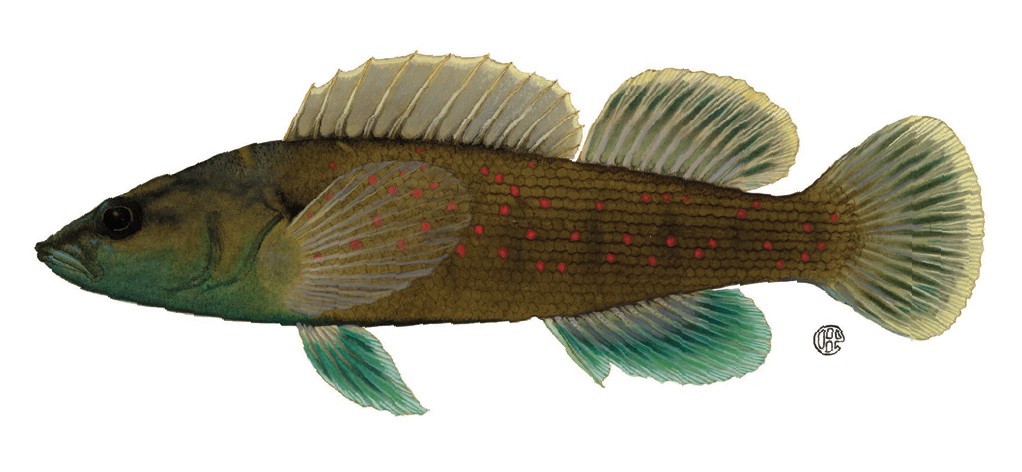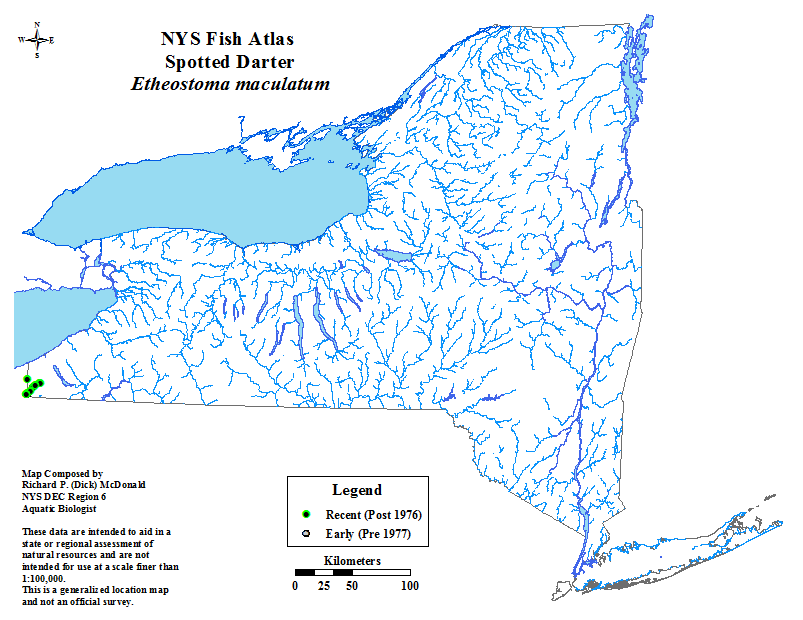
Spotted Darter (Etheostoma maculatum)
In New York, this species occurs only in French Creek where it was moderately common in 1975 and 1979. The subspecies Etheostoma maculatum maculatum ranges southwest through the northern tributaries of the Ohio River. There is an old record from the Tippecanoe River in Indiana, but no specimens have been reported from that state since the turn of the century and it is now scarce and sporadically distributed in Ohio as well. It is present in the Green River in Kentucky but is now scarce.
In French Creek, this species was collected only in the deepest and fastest parts of the riffles where the water was more than a foot deep and there were large rocks with abundant growths of filamentous algae.
The breeding habits of this colorful species were described in French Creek in Erie County, Pennsylvania. The spawning area was in a stream about 100 feet wide and the nests were located in water 6 inches to 2 feet deep, usually in quiet water at the head of a riffle. The minimum distance between nests was approximately 4 feet, suggesting territoriality. Breeding took place in May and early June when the water temperature had reached 17 C.
The eggs were deposited on the undersides of flat stones 3 to 9 inches in diameter. Usually the egg mass was somewhat squarish, with the eggs in 4 or 5 layers along one side and in 5 to 10 layers on the opposite side. The eggs were about 2 mm in diameter and yellow in color with a bright golden-yellow oil droplet. Most of the egg masses being guarded by males contained 288 to 352 eggs. Smaller masses usually had a female in attendance and were assumed to be incomplete.
The ovarian eggs mature in batches of about 65. Raney and Lachner suggested that females may spawn 2 to 4 times during the 5-week season. Ovaries of fish collected in March contained 200 eggs (in females 40 to 45 mm) to 400 eggs (females 50 mm) .
The eggs are guarded exclusively by the males. The length of the incubation period was not determined but eyed eggs were collected in the field and kept until they hatched. The newly hatched young were 5 to 6 mm long. Spotted darters reach slightly less than 30 mm by the end of their first summer. The sex ratio seemed to be unbalanced, 289 to 163 in favor of males, in a series of collections from various localities. Females first spawn at age 2 when they reach 44 mm and they average 50 mm at age 3. Males reach 48 mm at age 2 and may live to age 5. The largest male was 68 mm.
95 percent of the food of the spotted darter is aquatic insects, including dipterans (chiefly chironomids), stoneflies, mayflies, and beetles. Some water mites were eaten.
Distribution of spotted darter in NY state.
An image of the spotted darter is also available for download.
The above species description and all pictures of this fish were taken out of "The Inland Fishes of New York State" by C. Lavett Smith, published by the New York State Department of Environmental Conservation, 1985.
